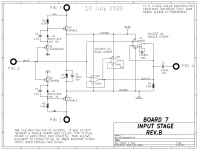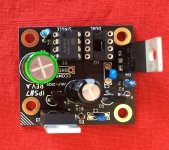What is sad about it? Like Pavel says, it is a hobby, a sport. Putting an end stage in a feedback loop with a high end opamp is just the best way to achieve these low distortion numbers at the moment. It is great fun to learn how these topologies work in practice. And they sound very well too. As a matter of fact, I am working on a multichannel amp for active speakers that I might make a available to others. The upper two channels will be looped class AB, the bass will come from Hypex ncore.That's a bit sad...🙂
Have you heard about rail bootstrap? I think Textronix used it first with nuvistors in 50's oscilloscopes.I honoured them by using germanium transistors 🙂What is sad about it? Like Pavel says, it is a hobby, a sport. Putting an end stage in a feedback loop with a high end opamp is just the best way to achieve these low distortion numbers at the moment. It is great fun to learn how these topologies work in practice. And they sound very well too. As a matter of fact, I am working on a multichannel amp for active speakers that I might make a available to others. The upper two channels will be looped class AB, the bass will come from Hypex ncore.
https://www.diyaudio.com/community/threads/germanium-foundation-chapter1.381869/#post-6961885
Since then I chsnged the 68 ohm res to 10 ohms ant yhe 10 ohms emittercres to 4.7 ohms so that I got more output and less clipping with opa2132 at +-5V.Now I play at +-1.5V with suitable op amps that does the job on 32 ohms headphones since the 90's.
For higher output on 250...600 ohms headphones class d chips are good enough at 12v supply .I bet you can't hear the difference btw 0.1% thd drivers and 0.0001%thd drivers on studio quality headphones.
Yet if you want to get serious about it:
https://www.analog.com/en/analog-dialogue/raqs/raq-issue-168.html
Last edited:
The "IPS7" input stage daughtercard for the diyAudio Store's "M2x" amp, uses bootstrapped rails. Builders rave about its wonderful sound quality.
Much later, I found out that someone applied for a UK patent on the idea, way back in 1979.
_
Much later, I found out that someone applied for a UK patent on the idea, way back in 1979.
_
Attachments
It is your output stage, in fact 🙂. Looking forward your results!@PMA,
I’m going to build this, simply because I have parts left over from the ExtremA which can be put to good use here.
Is the current limiting of Q1 and Q2 necessary for this amp to work safely? I find that amp topologies which have this employed don't sound as good as they can with transients into more difficult loads.
Same Sandman...The "IPS7" input stage daughtercard for the diyAudio Store's "M2x" amp, uses bootstrapped rails. Builders rave about its wonderful sound quality.
Much later, I found out that someone applied for a UK patent on the idea, way back in 1979.
_
More like the JBL "T" circuit, 1966: the emitters of the drivers are floating.Kind of resembles Figure 5 of US Patent # 3,995,228 issued to Nelson S. Pass on 30 Nov 1976.
PMA,Any PCB’s to share? I am still searching for the ultimate tweeter amp for my active dynaudio speakers.Now i am using “ the wire” with 8 x lme49600 and my own voltage regulators. Maybe are the regulators an upgrade for your amp.
PMA,Any PCB’s to share? I am still searching for the ultimate tweeter amp for my active dynaudio speakers.Now i am using “ the wire” with 8 x lme49600 and my own voltage regulators. Maybe are the regulators an upgrade for your amp.
I am not sure if to release Gerber files. The amp needs a large heatsink with very low °C/W thermal resistance. Sometimes it is difficult to reply to the bunch of questions when the Gerber files or PCBs are released.. So I better do it in case of preamps only, or very simple power amps.
Yes post #18 schematic is valid.
Thanks PMA.
Yes you are right. if you dont want to "waste" heat sink and build a big amp (3U 300mm as minimum --> up to 4U 400) then it is not your world.
i am building lots of amps and i am very sorry that you decide to do not public your gerbers.
i accept your decision.
kr
Chris
Happy Christmas to you and thanks for your very nice amps and EE competences to share.
Yes you are right. if you dont want to "waste" heat sink and build a big amp (3U 300mm as minimum --> up to 4U 400) then it is not your world.
i am building lots of amps and i am very sorry that you decide to do not public your gerbers.
i accept your decision.
kr
Chris
Happy Christmas to you and thanks for your very nice amps and EE competences to share.
Have you found your ultimate tweeter amp yet?PMA,Any PCB’s to share? I am still searching for the ultimate tweeter amp for my active dynaudio speakers.Now i am using “ the wire” with 8 x lme49600 and my own voltage regulators. Maybe are the regulators an upgrade for your amp.
In a local forum that involves some serious professionals with extended analog design experience there is a discusion on this post. How could you measure a THD of this magnitude? There is not too many instruments out there in this range..
Then how come the power amp’s overall distortion value is better than the opamp’s own distortion? How is it possible?
Then how come the power amp’s overall distortion value is better than the opamp’s own distortion? How is it possible?
- Home
- Amplifiers
- Solid State
- Small class A amplifier with THD below 0.0001%

